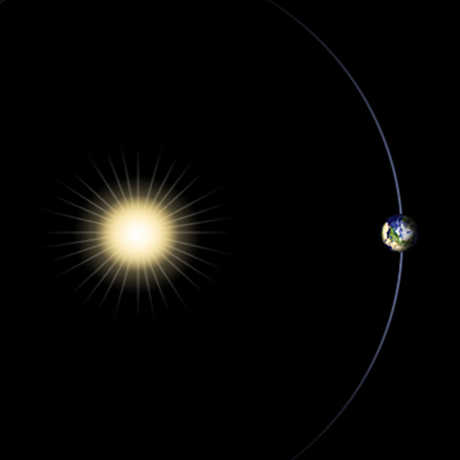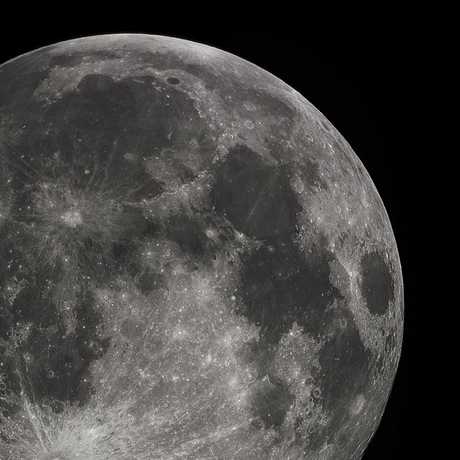
How much space is truly in space? And how does the distance between things affect the ways that objects in space are perceived?
This activity leads students to explore the concepts of size, distance and scale through using 3-dimensional models to understand these question in regards to the Earth, the Moon, and the Sun. Students begin with thinking about their own internal mental models, then use different sized balls in order to develop an explanation for why solar eclipses happen.
By the end of this activity students will be able to:
- use a model to describe why and how a solar eclipse happens.
- describe how the sizes of and distances between objects affects what can be observed.
Note: This lesson is written assuming the Sun to be a 48” ball. However, it can be done with smaller dimensions by dividing everything in half.
Each group of 4 students will need the following:
- 48 inch ball [very large beach ball] to represent the Sun
- 4.5 inch ball to represent the Earth
- 0.48 inch ball to represent the Moon
- Yard Stick
- 11.25 ft piece of string
- An area that is > 164 yards long
- A notebook
- Try the activity for yourself before leading it.
- This activity can stand alone, or can come after doing “Kinesthetic Astronomy” and “Moons in Comparison.”
- Gather your materials. Teacher Tip:
- Blow up the beach balls - It takes about 20 minutes to blow up a 48” beach ball with a hand pump.
- Use playdough or clay to form the Earth Ball and the Moon Ball out of playdough instead of purchasing one.
- Figure out how you want to split students into groups of 4.
- Begin by letting students know that you will be exploring how the distance between the Sun, Moon, and Earth might affect what we see of them from planet Earth.
- If this is your first time addressing scale in the solar system, consider having your students do the assessment probe, “Sizing up the moon.”
- If your students are already familiar with the relative sizes of the Earth, Moon and Sun, have them begin by
- Turn-and-talk to a fellow student scientist, answering the questions: What have you observed about the Moon and Sun in the sky? How big do they look?
- Ask students to make a sketch or write some notes about how far apart they think the Sun, Moon, and Earth are from each other.
- Then, share with students that today you will be using a scientific practice, called “modeling” to explore how the distance between the Sun, Moon, and Earth might affect what we see of them from planet Earth. For any scale model activity, it is useful to start by exploring the notion of models. Playthings, such as dolls or toy cars, can be a useful reference for talking about scale models.
- Split the students up into small groups. Share the packages of supplies with each group. Ask them to look at the objects and think about how a scientist might use them to explore the question “How does the distance between the Sun, Moon, and Earth affect what we see of them from planet Earth?”
- Give them some time to play with the supplies, and develop an idea for how they might be used to model the size and distance of the objects. (48 inch ball = Sun, 4.5 inch ball = Earth, and the 0.48 inch ball = Moon)
- Have students choose which role they will be: Earth, Sun, Moon and observer (if you have groups of 4). Each solar system object can hold the appropriate ball. The observer can hold the bag with the other items.
- Let students know we will be exploring the Earth-Moon distances first. Have one person hold the Moon and have one person stand in front of the Moon holding the Earth. Other students can stand alongside watching to make predictions and observations.
- Ask students to estimate the approximate distances between Earth and the Moon. To do this, have Earth stand still and have the Moon move slowly away. Make a mark on the ground each time a student thinks they are the correct distance apart.
- Ask students questions such as: What did you notice about the size the Moon or Earth as it moved away from you? Did it look bigger, smaller, or does it look the same?
- If needed, repeat the Moon walking away from the Earth so that students can see that as an object moves farther way it appears to become smaller. To help reinforce this idea, ask student if the object is really getting smaller.
- Let students know they will be using this idea that objects farther away appear smaller in the next part of the activity.
- Have students grab the Sun ball. If you have an observer, instruct them to stand next to the Earth at all times.
- Bring out the 11.25 foot string. Let students know this is the average distance between the Earth and the Moon at this scale. Instruct the Earth and Moon students to always hold one end of the string and keep it tight. This will help them keep the correct distance between them at all times.
- Inform them that we live in a special place in our Solar System, where the Sun and the Moon appear to be the same size in our sky. Ask students, how might we make the tiny Moon and the large Sun appear to be the same size if we are looking from the Earth? That is the challenge!
- Allow your students time to figure out how to create this model themselves, without your instructions. The model creation process should resemble something like this:
- the Sun stands at one end of the field.
- the Moon positions itself between the Earth and Sun.
- the observer stands next to the Earth at all times.
- the Moon-Earth system walks away from the Sun until the Earth/observer perceives the Sun and the Moon to be the same size. This will be about 164 yards.
- Once your students have created a model, let students switch roles to see the different perspectives.
- Lead a discussion in which students describe how the Moon could block out the Sun completely. Introduce the definition of a solar eclipse.
- Solar eclipse is a type of eclipse that occurs when the Moon passes between the Sun and Earth, and the Moon fully or partially blocks the Sun.
- Have students go back to their original ideas about the sizes and distances of the Moon, Earth and Sun. Ask them to discuss with each other: How have your ideas changed? Was there anything that surprised you?
Creating different types of eclipses: If you have one group of students finish the activity early, or you have the time, pose some “challenge” questions to your students:
- What would happen if the Moon were two feet closer to the Earth? How might that change what is seen from Earth? Does the Moon still cover the Sun?
- What would happen if the Moon were four steps away from the Earth? Would the Earth still cover the Sun?
- Answer: the Moon does not block out the Sun completely when it is a little farther away. Explain that this is a different type of eclipse called an Annular Eclipse.
How much space is truly in space? And how does the distance between things affect the ways that objects in space are perceived?
This activity leads students to explore the concepts of size, distance and scale through using 3-dimensional models to understand these question in regards to the Earth, the Moon, and the Sun. Students begin with thinking about their own internal mental models, then use different sized balls in order to develop an explanation for why solar eclipses happen.
Scientists develop and use models in order to explore how systems work. They can help make a concept that is hard to see become visible. The Next Generation Science Standards state that by the end of 5th grade, students should be able to use models to describe and/or predict phenomena. Additionally, the standards also mention that students should be able to “identify the limitations of models.”
Common Misperceptions
Models and illustrations of the Solar System often represent either size or distances in the solar system because it can be difficult to combine them into one model. This can cause the common misperceptions that the objects in the solar system are close together, or that they are all of similar sizes. This activity in combination with the activity “Moons in Comparison”, can help educators address the common misconceptions that are prevalent.
Additionally, for younger students, they may not realize that objects that are farther away look smaller.
Size
To model the distances between bodies in our solar system accurately where the distance between the Sun and Pluto in the model is 350 feet, the Sun would be 1" in diameter and most of the planets would appear no larger than tiny specks. Thus, it is difficult to accurately model both the sizes of the bodies in our solar system and the distances between them in the same model.
For this model, if you strictly convert the Sun-Earth-Moon system dimensions (diameter of objects and distances of objects), the Sun would be the 48 inch ball, and the Earth (0.5 inch ball) and the Moon (0.1 inch ball, size of a grain of rice) would be 1.25 football fields away. Therefore we enlarged the Earth-Moon system so students will be able to have an easier time visualizing the Moon being apparently the same size as the Sun.
Types of solar eclipses:
A total solar eclipse occurs when the Sun and Moon are exactly in line with the Earth and their apparent sizes are equal, allowing the much fainter solar corona to be visible. During any one eclipse, totality occurs at best only in a narrow track on the surface of Earth.
An annular solar eclipse occurs when the Sun and Moon are exactly in line with the Earth, but the apparent size of the Moon is smaller than that of the Sun. Hence the Sun appears as a very bright ring, or annulus, surrounding the dark disk of the Moon.
If you want to connect to algebra (not necessary for the activity):
In astronomy, the apparent sizes of celestial objects are often given in terms of their angular diameter as seen from Earth, rather than their actual sizes. Since these angular diameters are typically small, it is common to present them in arcseconds. An arcsecond (“) is one 3,600th of 1 degree, and 1 radian is 180 degrees/pi, so 1 radian is about 206,265 arcseconds. Therefore, the angular diameter of an object with physical diameter d at a distance D, expressed in arcseconds, is given by (206,265*d)/D arcseconds.
When calculated, the Sun’s angular diameter is between 31’31” and 32’33” depending on where the Earth is in its orbit. The Moon’s angular diameter has a larger range 29’20” to 34’6”. This means at times the Sun and the Moon’s apparent sizes are the same. When both apparent sizes and the objects physically align, places on Earth will observe a total solar eclipse. When the Moon appears to be slightly smaller than the Sun and the objects physically align, leaving the Sun’s visible outer edges, this is called an annular solar eclipse.
moon: A natural object that orbits a larger object.
eclipse: when one celestial body such as a moon or planet moves into the shadow of another celestial body.
solar eclipse: a type of eclipse that occurs when the Moon passes between the Sun and Earth, and the Moon fully or partially blocks the light from the Sun.
Science and Engineering Practices
- Developing and Using Models
- Develop and use models to describe phenomena
- Using Mathematics and Computational Thinking
- Apply mathematical concepts and/or processes to scientific and engineering questions and problems
Disciplinary Core Ideas
- ESS1.B: Earth and the Solar System: The solar system consists of the Sun and a collection of objects including planets, their moons, and asteroids that are held in orbit around the Sun by its gravitational pull on them.
Cross-Cutting Concepts
- Scale, Proportion and Quantity
- Time, space and energy phenomena can be observed at various scales using models to study systems that are too large or too small.
- Systems and System Models
- Can describe a system in terms of its component and their interactions.
- Models can be used to represent systems and their interactions
The activity outlined here is just one step toward reaching the Performance Expectations listed below. Additional supporting materials and lessons will be required.
MS-ESS1-2: Develop and use a model to describe the role of gravity in the motions within galaxies and the solar system
MS-ESS1-3: Analyze and interpret data to determine scale properties of objects in the solar system


